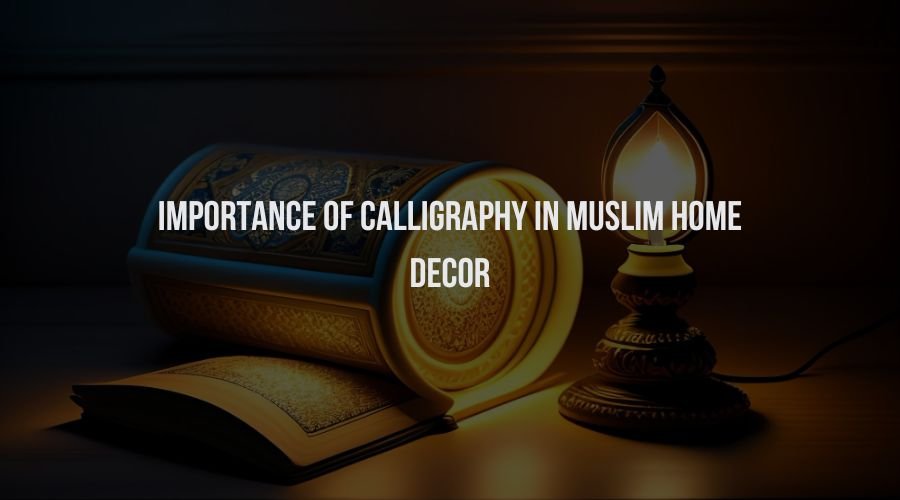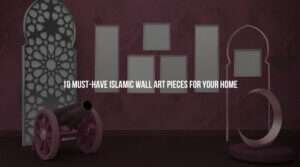Islamic calligraphy is a distinctive art style with great spiritual and cultural value. Islamic calligraphy has a deep historical background and aesthetic appeal, making it a great way to add inspiration and harmony to any interior design project.
Discover how to infuse Islamic calligraphy into muslim home decor to improve the inner sanctuary of your home. Islamic calligraphy is another fascinating technique to add cultural depth to a living area, even for non-religious people.
Islamic Calligraphy: What Is It?
Arabic script is written with skill and intricacy in Islamic calligraphy, a highly esteemed art form within the Islamic tradition. Due to its frequent application in the transcription of passages from the Quran and other holy books, it has great cultural and religious value.
It is still revered as a potent icon of Islamic culture despite its lengthy and rich history.
How Can Arabic Calligraphy Be Used in Muslim Home Decor?
1. Being Aware of Interior Design
Understanding the foundations ofIslamic decor is crucial before introducing Islamic calligraphy into the space. The homeowner’s preferences, way of life, available space, and current decor should all be taken into account. This knowledge will make it easier to integrate Islamic calligraphy while maintaining a unified and welcoming environment.
2. Examining Islamic Calligraphy's Beauty
The practice of writing Arabic script in an elegant manner is known as Islamic calligraphy. It frequently concentrates on passages called ayahs from the Quran, the sacred scripture of Islam. Every ayah has a deep spiritual significance. Selecting and studying the right ayahs—such as those that emphasise love, unity, and family values—can be a significant place to start when integrating Islamic calligraphy into muslim home decor.
3. Strategically placing Calligraphy Artwork
Decide which areas of the house will make the best displays for Islamic calligraphy. Living rooms, dining rooms, foyers, and prayer rooms are common options. These spaces offer great chances to display calligraphic artwork as decals, framed canvases, or wall hangings.
Choose larger pieces to make a statement, or use Surahs and other calligraphic motifs to create a gallery wall that adds visual interest and depth.
4. Balancing Traditional and Modern Elements
A well-balanced combination of contemporary Islamic decor components and classical Islamic calligraphy is essential for young families looking for a contemporary aesthetic. Select calligraphic artwork that features elegant text, neutral hues, and clear lines to portray a modern and minimalist aesthetic.
Traditional Arabic calligraphy or Islamic art set on a modern background will produce an engrossing and eye-catching atmosphere.
5. Choosing the Right Materials and Fonts
The calligraphy font selection really contributes to the overall theme of the muslim home decor. Select contemporary calligraphy designs that are both aesthetically beautiful and readable.
Try out several fonts and sizes to discover the ideal combination that complements the family’s preferences and the room’s intended ambiance. Think about using materials like acrylic, metal, wood, or canvas to provide depth and a variety of textures to your artwork.
6. Lighting with Proper Illumination
The beauty of calligraphy artwork is enhanced, and it ‘s fine details are highlighted by appropriate illumination. Try several lighting options, such as wall sconces, spotlights, and adjustable fixtures, to provide an eye-catching and dramatic impact. While accent lighting can draw attention to particular calligraphic items, soft and warm lighting can help to create a calm atmosphere.
7. Including Calligraphy in Useful Objects
Consider adding Islamic calligraphy to practical objects like rugs, pillows, or dinnerware to further incorporate it into daily life. Adorn fabrics with Surahs or calligraphic designs serve as a continual reminder of the family’s morals and beliefs. This gives the living area an intimate touch while also improving the overall decor.
8. How to Make a Reflection Area
Families looking for a room set apart for prayer and spiritual reflection can add a thoughtfully planned reflection area. Here, one can see the art of Islamic calligraphy on full show, with prayer mats and walls adorned with thoughtfully chosen ayahs. This area will function as a calm haven for introspection and prayer, encouraging a closer relationship with one’s religion.
Islamic calligraphy is a unique way to commemorate cultural history, express your beliefs, and create a peaceful living environment. It can be used in Islamic decor. A captivating blend of tradition and modernity can be created by grasping interior design concepts, choosing the right Ayahs, striking a balance between traditional and modern features, and putting calligraphic artwork thoughtfully.
Accepting the beauty of Islamic calligraphy in the house not only improves the aesthetics but also gives the family a stronger feeling of spirituality and cultural identity.
What Role Does Calligraphy Play in Islamic Art?
Islamic calligraphy is significant because it serves as a visual depiction of the divine word of the Qur’an, embodying it. Islamic calligraphy art captivates the hearts and souls of both art aficionados and believers with its wonderful fusion of beauty and devotion.
Islamic calligraphy evolved as a way to describe calligraphy and its significance in Islamic culture and art since representations of God or prophets are typically avoided in Islamic art. It emerged as the principal means of disseminating religious literature, guaranteeing that the Qur’anic teachings were accorded the appropriate respect. The written word is revered and frequently embellished with elaborate designs and patterns, particularly when it comes to sacred texts.
What is the Use of Islamic Calligraphy in Muslim Home Decor?
Islamic calligraphy offers aesthetic appeal and spiritual importance to environments when it is applied in Islamic decor. This art style, which has its roots in Islamic history, transforms public and private settings by reflecting the divine spirit of the Quran.
Quranic passages are carved on walls, ceilings, and arches in a multitude of opulent mosques and buildings. Beyond these opulent buildings, commonplace items are also adorned with Islamic calligraphy. Calligraphic themes are frequently found in ceramics, textiles, and furniture, fusing art with daily life.




